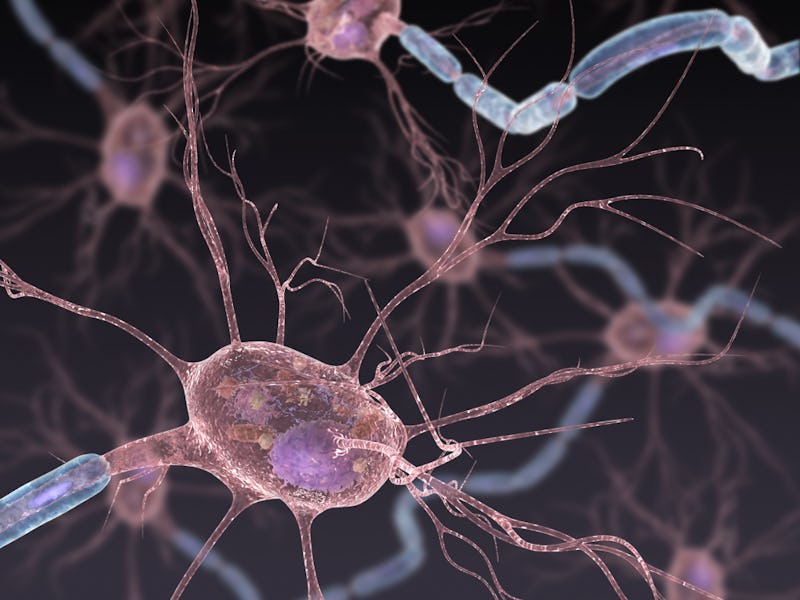Hijacking the "fight or flight" response could lead to life-saving cancer treatments
An infamous nervous system reaction influences cancer immunity.

When people face threats in the environment, like an attack or confrontation, the body's evolutionarily embedded defense system called "fight or flight" kicks in.
The fight or flight response is a core feature of the sympathetic nervous system — ramping up blood flow throughout the body, dilating pupils, and releasing hormones like norepinephrine.
This cascade of bodily shifts prepares people to either meet an outside threat head-on or run for their lives. It also influences the immune system and its ability to fight off a foreign invader once it makes its way inside the body.
In a recent study exploring how stress signals influence immunity in mice, researchers found that changes in the body's sympathetic nervous system also influence immune responses to one of society's most dreaded diseases: cancer.
James Nevin and Pramod Srivastava are co-authors of the new study and researchers in the department of immunology at the University of Connecticut School of Medicine.
"Our research shows that the nervous system is in constant control of the development of immune cells, which are required for fighting cancers and infections," Nevin and Srivastava tell Inverse in a joint email. "Key parts of the immune system are not able to develop normally in the absence of signals from the nervous system; indeed, they develop abnormally. These abnormal immune cells are quite deleterious for fighting cancer and potentially, infections."
If further research confirms the team's early findings, it could change the way we treat cancer patients for years to come. The study was published Friday in the journal Science Immunology.
"Our work shows that manipulation of the nervous system can change the immune response to cancer," the researchers say.
Stress science — Stress, which triggers the body's fight or flight response, is a normal state in life. Sometimes it subsides minutes after an event like a high-pressure work presentation or test. In other scenarios, like caring for an ill loved one or going through a divorce, it can last for much longer.
Scientists know chronic, long-term stress can negatively influence immunity by increasing inflammation and decreasing levels of white blood cells called lymphocytes. It's also been shown that heightened sympathetic nervous system activity due to stress can impair effective cancer immunity.
Nevin and Srivastava say the nervous system and the immune system are "tightly interlinked."
"... manipulation of the nervous system can change the immune response to cancer."
Diving into this dynamic, researchers studied a group of mice implanted with cancerous tumors. The team manipulated these animals' sympathetic nervous system, disrupting its ability to produce norepinephrine, a pivotal stress hormone.
This disruption threw off the body's stress signaling system and quelled a critical α-adrenergic signal. Without this signal, myeloid-derived suppressor cells weren't able to mature and immature cells accumulated. These immature, abnormal cells can suppress immunity and promote the growth of tumors.
Essentially, researchers inhibited certain sympathetic signaling processes, effectively ramping up tumor growth in cancerous mice.
"We show that a steady but low-level sympathetic nervous signal is required to drive the maturation of immune cells capable of fighting tumors, and potentially infections," Nevin and Srivastava explain.
Disruption of norepinephrine signaling in sympathetic neurons prevented the maturation of myeloid cells, leading to the generation of immature myeloid cells that suppressed antitumor immunity and promoted growth of tumors in cancer mouse models.
The future of fighting cancer — The results suggest that in the future, scientists may be able to manipulate sympathetic signaling in humans too, helping circumvent immunosuppression during cancer.
Ultimately, this process holds the potential for improving how patients respond to immunotherapy cancer treatments.
"We have uncovered a large area of nexus between the immune and the nervous systems; this nexus was previously unknown," Nevin and Srivastava say.
"Through our understanding of this nexus, we can now envision how drugs that manipulate sympathetic nervous system signaling pathways (e.g. beta-blockers, ADHD medication, some anti-depressants, etc.) might have beneficial or detrimental effects on immune function."
And according to the researchers, this future is surprisingly near. Because researchers already use a number of FDA approved drugs that influence sympathetic nervous signalings, like beta-blockers and ADHD medication, "we can and will piggyback on this knowledge and apply it to human cancer," the researchers say.
"Since these drugs are already developed and known to be safe, the time to human translation of our ideas will be pleasantly short."
Abstract: Sympathetic nerves that innervate lymphoid organs regulate immune development and function by releasing norepinephrine that is sensed by immune cells via their expression of adrenergic receptors. Here, we demonstrate that ablation of sympathetic nervous system (SNS) signaling suppresses tumor immunity, and we dissect the mechanism of such immune suppression. We report that disruption of the SNS in mice removes a critical a-adrenergic signal required for maturation of myeloid cells in normal and tumor-bearing mice. In tumor-bearing mice, disruption of the a-adrenergic signal leads to the accumulation of immature myeloid-derived suppressor cells (MDSCs) that suppress tumor immunity and promote tumor growth. Furthermore, we show that these SNS-responsive MDSCs drive expansion of regulatory T cells via secretion of the alarmin heterodimer S100A8/A9, thereby compounding their immunosuppressive activity. Our results describe a regulatory framework in which sympathetic tone controls the development of innate and adaptive immune cells and influences their activity in health and disease.
This article was originally published on